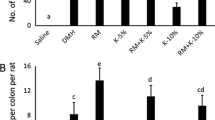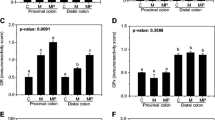Abstract
Purpose
We have shown previously that long-term feeding of beef tallow increases colorectal cancer in rats. This study investigated the effects of enzymic antioxidant, reduced glutathione (GSH), on colon carcinogenesis in rats fed with beef tallow.
Methods
Colon carcinogenesis was induced by intraperitoneal injection of azoxymethane (AOM) to rats. Rats were fed with 10% beef tallow supplemented with or without 1% GSH in drinking water. Aberrant crypt foci (ACF) and expression of β-catenin in colonic mucosa were examined at 12 weeks. Cancers, related substances of oxidative stress and arachidonic acid cascade in plasma and normal colonic mucosa were determined at 44 weeks.
Results
GSH attenuated the number of ACF increased by beef tallow, but GSH had no influence on expression of β-catenin increased by AOM. Incidence of colon cancer was no different with or without GSH, but GSH attenuated the number of colon cancers in each rat. GSH suppressed plasma malondialdehyde concentration. GSH increased GSH concentration and activities of catalase, glutathione peroxidase and superoxide dismutase in colonic mucosa, and decreased cyclooxygenase-2, prostaglandin E2 and thromboxane B2 levels.
Conclusions
This study indicated that GSH suppressed the number of ACF, but the attenuation of colon carcinogenesis was limited to the number of colon cancers, although anti-oxidative effects and suppressive effects of arachidonic acid cascade were demonstrated by several indexes. These results suggested that colon carcinogenesis enhanced by beef tallow was partly caused by oxidative stress and arachidonic acid cascade, which were reduced by GSH.






Similar content being viewed by others
Abbreviations
- ACF:
-
Aberrant crypt foci
- AOM:
-
Azoxymethane
- GSSG:
-
Glutathione disulfide
- GSH:
-
Reduced glutathione
- COX-2:
-
Cyclooxygenase-2
References
Bostick RM, Potter JD, McKenzie DR, Sellers TA, Kushi LH, Steinmetz KA, et al. Reduced risk of colon cancer with high intake of vitamin E: the Iowa Women’s Health Study. Cancer Res. 1993;53:4230–7.
Bartoli R, Femandez-Banares F, Navarro E, Castella E, Mane J, Alvarez M, et al. Effect of olive oil on early and late events of colon carcinogenesis in rats: modulation of arachidonic acid metabolism and local prostaglandin E2 synthesis. Gut. 2000;46:191–9.
Riboli E, Norat T. Epidemiologic evidence of the protective effect of fruit and vegetables on cancer risk. Am J Clin Nutr. 2003;78:559–69.
Willett WC, Stampfer MJ, Colditz GA, Rosner BA, Speizer FE. Relation of meat, fat, and fiber intake to the risk of colon cancer in a prospective study among women. N Engl J Med. 1990;323:1664–72.
Fujise T, Iwakiri R, Kakimoto T, Shiraishi R, Sakata Y, Wu B, et al. Long-term feeding of various fat diets modulates azoxymethane-induced colon carcinogenesis through Wnt/beta-catenin signaling in rats. Am J Physiol. 2007;292:G1150–6.
Ohishi T, Kishimoto Y, Miura N, Shiota G, Kohri T, Hara Y, et al. Synergistic effects of (-)-epigallocatechin gallate with sulindac against colon carcinogenesis of rats treated with azoxymethane. Cancer Lett. 2002;177:49–56.
Sengupta A, Ghosh S, Das S. Modulatory influence of garlic and tomato on cyclooxygenase-2 activity, cell proliferation and apoptosis during azoxymethane induced colon carcinogenesis in rat. Cancer Lett. 2004;208:127–36.
Sohn OS, Ishizaki H, Yang CS, Fiala ES. Metabolism of azoxymethane, methylazoxymethanol and N-nitrosodimethylamine by cytochrome P450IIE1. Carcinogenesis. 1991;12:127–31.
Stadler RH, Turesky RJ, Muller O, Markovik J, Leong Morgenthaler PM. The inhibitory effects of coffee on radical mediated oxidation and mutagenicity. Mutat Res. 1994;308:177–90.
Prestera T, Zhang Y, Speaker SR, Wilczak C, Tacalay P. The electrophilic counterattack responses: protection against neoplasia and toxicity. Adv Enzyme Regul. 1993;33:281–96.
Van Leishout EMM, Peters WHM, Jansen JBMJ. Effect of oltipraz, α-tocopherol, β-carotene and phenyl isothiocyanate on rat oesophageal, gastric, colonic and hepatic glutathione, colonic and hepatic glutathione, glutathione S-transferase and peroxidase. Carcinogenesis. 1996;17:1439–45.
Ashokkumar P, Sudhandiran G. Protective role of luteolin on the status of lipid peroxidation and antioxidant defense against azoxymethane-induced experimental colon carcinogenesis. Biomed Pharmacother. 2008;62:590–7.
Sreedharan V, Venkatachalam KK, Namasivayam N. Effect of morin on tissue lipid peroxidation and antioxidant status in 1, 2-dimethylhydrazine induced experimental colon carcinogenesis. Invest New Drugs. 2009; in press.
Tanaka T, Kojima T, Suzui M, Mori H. Chemoprevention of colon carcinogenesis by the natural product of a simple phenolic compound protocatechuic acid: suppressing effects on tumor development and biomarkers expression of colon tumorigenesis. Cancer Res. 1998;53:3908–13.
Ramanathan R, Das NP, Tan CH. Inhibition of tumor promotion and cell proliferation by plant polyphenols. Phytother Res. 1994;8:293–6.
Thresiamma KC, George J, Kuttan R. Protective effect of curcumin, ellagic acid and bixin on radiation induced genotoxicity. J Exp Clin Cancer Res. 1994;17:431–4.
Ross JA, Kasum CM. Dietary flavonoids: bioavailability, metabolic effects and safety. Annu Rev Nutr. 2002;22:19–34.
Strużńka L, Chalimoniuk M, Sulkowski G. The role of astroglia in Pb-exposed adult rat brain with respect to glutamate toxicity. Toxicology. 2005;212:185–94.
Bird RP. Observation and quantification of aberrant crypts in the murine colon treated with a colon carcinogen: preliminary findings. Cancer Lett. 1987;37:147–51.
Noda T, Iwakiri R, Fujimoto K, Matsuo S, Aw TY. Programmed cell death induced by ischemia-reperfusion in rat intestinal mucosa. Am J Physiol. 1998;274:G270–6.
Takayama T, Ohi M, Hayashi T, Miyanishi K, Nobuoka A, Nakajima T, et al. Analysis of K-ras, APC, and beta-catenin in aberrant crypt foci in sporadic adenoma, cancer, and familial adenomatous polyposis. Gastroenterology. 2001;121:599–611.
Pretow TP, Cheyer C, O’Riordan MA. Aberrant crypt foci and colon tumors in F344 rats have similar increases in proliferative activity. Int J Cancer. 1994;56:599–602.
Pretow TP, O’Riordan MA, Somich GA, Amini SB, Pretlow TG. Aberrant crypts correlate with tumor incidence in F344 rats treated with azoxymethane and phytate. Carcinogenesis. 1992;13:1509–12.
Baker MA, Cerniglia GJ, Zaman A. Microtiter plate assay for the measurement of glutathione and glutathione disulfide in large numbers of biological samples. Anal Biochem. 1990;190:360–5.
Ursini F, Maiorino M, Brigelius-Flohé R, Aumann KD, Roveri A, Schomburg D, et al. Diversity of glutathione peroxidase. Meth Enzymol. 1995;252:38–53.
Wheeler CR, Salzman JA, Elsayed NM, Omaye ST, Korte DW Jr. Automated assays for superoxide dismutase, catalase, glutathione peroxidase, and glutathione reductase activity. Anal Biochem. 1990;184:193–9.
Sutherland MW, Learmonth BA. The tetrazolium dyes MTS and XTT provide new quantitative assays for superoxide and superoxide dismutase. Free Radic Res. 1997;27:283–9.
Arvind P, Papavassiliou ED, Tsioulias GJ, Quiao L, Lovelace CI, Duceman B, et al. Prostaglandin E2 down-regulates the expression of HLA-DR antigen in human colon adenocarcinoma cell lines. Biochemistry. 1995;34:5604–9.
Lawson JA, Patrono C, Ciabattoni G, Fitzgerald GA. Long-lived enzymatic metabolites of thromboxane B2 in the human circulation. Anal Biochem. 1986;155:198–205.
Yagi K. Simple assay for the level of total lipid peroxides in serum or plasma. Methods Mol Biol. 1998;108:101–6.
Sengottuvelan M, Senthilkumar R, Nalini N. Modulatory influence of dietary resveratrol during different phases of 1, 2-dimethylhydrazine induced mucosal lipid-peroxidation, antioxidant status and aberrant crypt foci development in rat colon carcinogenesis. Biochim Biophys Acta. 2006;1760:1175–83.
Devasena T, Menon VP, Rajasekharan KN. Prevention of 1, 2-dimethylhydrazine -induced circulatory oxidative stress by bis-1, 7-(2-hydroxyphenyl)- hepta -1, 6-diene-3, 5-dione during colon carcinogenesis. Pharmacol Rep. 2006;58:229–35.
Pitot HC. Fundamentals of oncology. Newyork: Informa Healthcare, Inc.; 2002.
Sengottuvelan M, Viswanathan P, Nalini N. Chemopreventive effect of trans-resveratrol - a phytoalexin against colonic aberrant crypt foci and cell proliferation in 1, 2-dimethylhydrazine induced colon carcinogenesis. Carcinogenesis. 2006;27:1038–46.
Yamada Y, Yoshimi N, Hirose Y, Matsunaga K, Katayama M, Sakata K, et al. Sequential analysis of morphological and biological properties of beta-catenin-accumulated crypts, provable premalignant lesions independent of aberrant crypt foci in rat colon carcinogenesis. Cancer Res. 2001;61:1874–8.
Yamada Y, Yoshimi N, Hirose Y, Kawabata K, Matsunaga K, Shimizu M, et al. Frequent beta-catenin gene mutations and accumulations of the protein in the putative preneoplastic lesions lacking macroscopic aberrant crypt foci appearance, in rat colon carcinogenesis. Cancer Res. 2000;60:3323–7.
Arthur JR. The glutathione peroxidases. Cell Mol Life Sci. 2000;57:1825–35.
Mishra P, Kale RK, Kar A. Chemoprevention of mammary tumorigenesis and chemomodulation of the antioxidative enzymes and peroxidative damage in prepubertal Sprague Dawley rats by Biochanin A. Mol Cell Biochem. 2008;312:1–9.
Amstad P, Cerutti P. Genetic modulation of the cellular antioxidant defense capacity. Environ Health Perspect. 1990;88:77–82.
Cerutti P, Ghosh R, Oya Y, Amstad P. The role of the cellular antioxidant defense in oxidant carcinogenesis. Environ Health Perspect. 1994;102(suppl 10):123–9.
Manju V, Balasubramaniyan V, Nalini N. Rat colonic lipid peroxidation and antioxidant status: the effects of dietary luteolin on 1, 2-dimethylhydrazine challenge. Cell Mol Biol Lett. 2005;10:535–51.
Kamaleeswari M, Nalini N. Dose-response efficacy of caraway (Carum carvi L.) on tissue lipid peroxidation and antioxidant profile in rat colon carcinogenesis. J Pharm Pharmacol. 2006;58:1121–30.
Giftson JS, Jayanthi S, Nalini N. Chemopreventive efficacy of gallic acid, an antioxidant and anticarcinogenic polyphenol, against 1,2-dimethyl hydrazine induced rat colon carcinogenesis. Invest New Drugs 2009; in press.
Witschi A, Reddy S, Stofer B, Lauterburg BH. The systemic availability of oral glutathione. Eur J Clin Pharmacol. 1992;43:667–9.
Tsunada S, Iwakiri R, Noda T, Fujimoto K, Fuseler J, Rhoads CA, et al. Chronic Exposure to Subtoxic Levels of Peroxidized Lipids Suppresses Mucosal Cell Turnover in Rat Small Intestine and Reversal by Glutathione. Dig Dis Sci. 2003;48:2333–41.
Grattagliano I, Wieland P, Schranz C, Lauterburg BH. Effect of oral glutathione monoethyl ester and glutathione on circulating and hepatic sulfhydrils in the rat. Pharmacol Toxicol. 1994;75:343–7.
Harris RE, Beebe-Donk J, Doss H, Burr Doss D. Aspirin, ibuprofen, and other non-steroidal anti-inflammatory drugs in cancer prevention: a critical review of non-selective COX-2 blockade (review). Oncol Rep. 2005;13:559–83.
Rahme E, Barkun AN, Toubouti Y, Bardou M. The cyclooxygenase-2-selective inhibitors rofecoxib and celecoxib prevent colorectal neoplasia occurrence and recurrence. Gastroenterology. 2003;125:404–12.
Harris RE, Beebe-Donk J, Alshafie GA. Similar reductions in the risk of human colon cancer by selective and nonselective cyclooxygenase-2 (COX-2) inhibitors. BMC cancer. 2008;8:237.
Iwama T. NSAIDs and colorectal cancer prevention. J Gastroenterol. 2009;44(Suppl 19):72–6.
Takayama T, Katsuki S, Takahashi Y, Ohi M, Nojiri S, Sakamaki S, et al. Aberrant crypt foci of the colon as precursors of adenoma and cancer. N Engl J Med. 1998;339:1277–84.
Watanabe K, Kawamori T, Nakatsugi S, Ohta T, Ohuchida S, Yamamoto H, et al. Role of the prostaglandin E receptor subtype EP1 in colon carcinogenesis. Cancer Res. 1999;59:5093–6.
Gilmore TD. The Rel/NF-kappaB signal transduction pathway: introduction. Oncogene. 1999;18:6842–4.
Panwalkar A, Verstovsek S, Giles F. Nuclear factor-kappaB modulation as a therapeutic approach in hematologic malignancies. Cancer. 2004;100:1578–89.
Rossi A, Kapahi P, Natoli G, Takahashi T, Chen Y, Karin M, et al. Anti-inflammatory cyclopentenone prostaglandins are direct inhibitors of IkappaB kinase. Nature (London). 2000;403:103–8.
Bowie AG, Moynagh PN, O’Neill LAJ. Lipid peroxidation is involved in the activation of NF-κB by tumour necrosis factor but not interleukin 1 in the human endothelial cell line ECV304. J Biol Chem. 1997;272:25941–50.
Ginn-Pease ME, Whisler RL. Optimal NF-κB-mediated transcriptional responses in Jurkat T cells exposed to oxidative stress are dependent on intracellular glutathione and costimulatory signals. Biochem Biophys Res Commun. 1996;226:695–702.
Acknowledgments
This work was supported in part by Grants-in-Aid for Scientific Research from Japan Society for the Promotion of Science (KAKEN) 20590728 (KF), 20790499 (TF) and 20590745 (RI).
Author information
Authors and Affiliations
Corresponding author
Rights and permissions
About this article
Cite this article
Shiraishi, R., Fujise, T., Kuroki, T. et al. Long-term ingestion of reduced glutathione suppressed an accelerating effect of beef tallow diet on colon carcinogenesis in rats. J Gastroenterol 44, 1026–1035 (2009). https://doi.org/10.1007/s00535-009-0101-3
Received:
Accepted:
Published:
Issue Date:
DOI: https://doi.org/10.1007/s00535-009-0101-3




